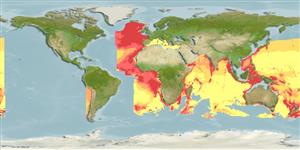Classification / Names
Common names from other countries
Main reference
Size / Weight / Age
Max length : 80.0 cm TL male/unsexed; (Ref. 9563); common length : 45.0 cm TL male/unsexed; (Ref. 9258)
Environment
Marine; bathypelagic; depth range 450 - 2500 m (Ref. 4774)
Climate / Range
Deep-water, preferred 24°C (Ref. 107945); 64°N - 51°S, 77°W - 174°W (Ref. 1371)
Distribution
Eastern Atlantic: Iceland and Faeroes to Cape Bojador, West Africa, and including Azores, Madeira, and western Mediterranean. Also known from the Walvis and Vavilov ridges (Ref. 45011). Reported from Mauritania (Ref. 55783). Western Indian Ocean: in the region south of Madagascar. Pacific Ocean: temperate Australia, New Zealand, and between Valparaiso, Chile and the Juan Fernandez Islands.
Countries | FAO areas | Ecosystems | Occurrences | Introductions
Short description
Dorsal
spines
(total): 0;
Dorsal
soft rays
(total): 54-59;
Anal
spines: 0;
Anal
soft rays: 18 - 21. Eyes relatively large, greater than snout length in diameter. Anal fin originating near midlength of body, deeply indented at midlength, sometimes appearing as two. Ventral light organ absent. Color is generally gray.
IUCN Red List Status (Ref. 115185)
Threat to humans
Harmless
Human uses
Fisheries: minor commercial
Tools
Special reports
Download XML
Internet sources
Estimates of some properties based on models
Phylogenetic diversity index
PD50 = 1.0000 many relatives (e.g. carps) 0.5 - 2.0 few relatives (e.g. lungfishes)
Trophic Level
3.8 ±0.55 se; Based on food items.
Resilience
Low, minimum population doubling time 4.5 - 14 years (Assuming tm>4)
Vulnerability
High vulnerability (61 of 100)
Price category
